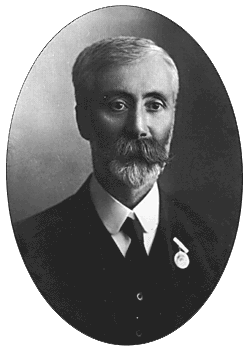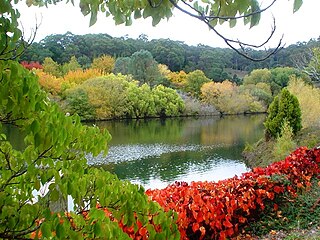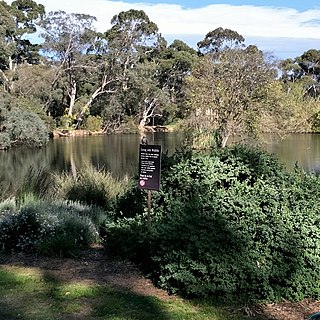
A botanical garden or botanic garden is a garden with a documented collection of living plants for the purpose of scientific research, conservation, display, and education. Typically plants are labelled with their botanical names. It may contain specialist plant collections such as cacti and other succulent plants, herb gardens, plants from particular parts of the world, and so on; there may be greenhouses, shadehouses, again with special collections such as tropical plants, alpine plants, or other exotic plants. Most are at least partly open to the public, and may offer guided tours, educational displays, art exhibitions, book rooms, open-air theatrical and musical performances, and other entertainment.

Port Augusta is a small city in South Australia. Formerly a seaport, it is now a road traffic and railway junction city mainly located on the east coast of the Spencer Gulf immediately south of the gulf's head and about 322 kilometres (200 mi) north of the state capital, Adelaide. The suburb of Port Augusta West is located on the west side of the gulf on the Eyre Peninsula. Other major industries included, up until the mid-2010s, electricity generation. At June 2018, the estimated urban population was 13,799, having declined at an average annual rate of -0.53% over the preceding five years.

Santos Ltd. is an Australian oil and gas exploration and production company, with its headquarters in Adelaide, South Australia. It owns liquefied natural gas (LNG), pipeline gas, and oil assets. It is the biggest supplier of natural gas in Australia, with its plants in the Cooper Basin in South Australia and South West Queensland supplying the eastern states of Australia. Its operations also extend to the seas off Western Australia and Northern Territory.

The Royal Botanic Garden, Sydney is a heritage-listed major 30-hectare (74-acre) botanical garden, event venue and public recreation area located at Farm Cove on the eastern fringe of the Sydney central business district, in the City of Sydney local government area of New South Wales, Australia.

The Adelaide Botanic Garden is a 51-hectare (130-acre) public garden at the north-east corner of the Adelaide city centre, in the Adelaide Park Lands. It encompasses a fenced garden on North Terrace and behind it the Botanic Park. Work was begun on the site in 1855, with its official opening to the public on 4 October 1857.

The South Australian Museum is a natural history museum and research institution in Adelaide, South Australia, founded in 1856 and owned by the Government of South Australia. It occupies a complex of buildings on North Terrace in the cultural precinct of the Adelaide Parklands. Plans are under way to move much of its Australian Aboriginal cultural collection, into a new National Gallery for Aboriginal Art and Cultures.

Joseph Henry Maiden was a botanist who made a major contribution to knowledge of the Australian flora, especially the genus Eucalyptus. This botanist is denoted by the author abbreviation Maiden when citing a botanical name.

The Art Gallery of South Australia (AGSA), established as the National Gallery of South Australia in 1881, is located in Adelaide. It is the most significant visual arts museum in the Australian state of South Australia. It has a collection of almost 45,000 works of art, making it the second largest state art collection in Australia. As part of North Terrace cultural precinct, the gallery is flanked by the South Australian Museum to the west and the University of Adelaide to the east.

Professor David John Mabberley, is a British-born botanist, educator and writer. Among his varied scientific interests is the taxonomy of tropical plants, especially trees of the families Labiatae, Meliaceae and Rutaceae. He is perhaps best known for his plant dictionary The plant-book. A portable dictionary of the vascular plants. The third edition was published in 2008 as Mabberley's Plant-book, for which he was awarded the Engler Medal in Silver in 2009. As of June 2017 Mabberley's Plant-book is in its fourth edition.

First opened in 1977, the crescent-shaped Mount Lofty Botanic Garden is situated on 100 hectares on the eastern slopes of Mount Lofty in the Adelaide Hills east of Adelaide in South Australia. The cooler, wetter location suits plants from temperate climates which are difficult to grow on the Adelaide Plains. Amongst the native Australian flora there are tree ferns, as well as exotic cultivated plants from cool climates including Rhododendron and Magnolia and the National Species Rose Collection. The Mount Lofty Botanic Garden, together with the Adelaide and Wittunga Botanic Gardens, is administered by the Botanic Gardens of South Australia, a State Government statutory authority.

The Wittunga Botanic Garden is one of three Botanic Gardens in Adelaide, South Australia administered by the Botanic Gardens of South Australia, a State Government statutory authority; the other two are the Adelaide Botanic Garden located in the inner city's parklands, and the Mount Lofty Botanic Garden. The Wittunga garden is located on Shepherds Hill Road, Blackwood, on the western scarp of the Adelaide Hills.

Adelaide Festival Centre, Australia's first capital city multi-purpose arts centre and the home of South Australia's performing arts, was built in the 1970s, designed by Hassell Architects. Located on Kaurna Yarta, the Festival Theatre opened in June 1973 with the rest of the centre following soon after. The complex includes Festival Theatre, Dunstan Playhouse, Space Theatre and several gallery and function spaces. Located approximately 50 metres (160 ft) north of the corner of North Terrace and King William Road, lying near the banks of the River Torrens and adjacent to Elder Park, it is distinguished by its two white geometric dome roofs, and lies on a 45-degree angle to the city's grid.

Carrick Hill is a publicly accessible historic property at the foot of the Adelaide Hills, in the suburb of Springfield, in South Australia. It was the Adelaide home of Sir Edward "Bill" Hayward and his wife Ursula, and contains a large collection of drawings, sculptures, antiques and paintings. Completed in 1939 and built in the style of an English manor, it is one of the few period homes in Australia to have survived with its grounds undiminished and most of its original contents intact.
The Conservation Council of South Australia, also known as Conservation SA and Conservation Council SA, is an environmental organisation serving as a peak body, representing over 50 member groups, representing over 90,000 individual members, in the state of South Australia.

Kew Gardens is a botanic garden in southwest London that houses the "largest and most diverse botanical and mycological collections in the world". Founded in 1840, from the exotic garden at Kew Park, its living collections include some of the 27,000 taxa curated by Royal Botanic Gardens, Kew, while the herbarium, one of the largest in the world, has over 8.5 million preserved plant and fungal specimens. The library contains more than 750,000 volumes, and the illustrations collection contains more than 175,000 prints and drawings of plants. It is one of London's top tourist attractions and is a World Heritage Site.
Joseph Whittaker was a British botanist who visited South Australia in 1839. Whittaker has 300 plants from that trip in Kew Gardens and a large collection of pressed British plants in Derby Museum and Art Gallery.

The State Herbarium of South Australia, sometimes called the South Australian Herbarium, and having the herbarium code, AD, is located in Adelaide, South Australia. It is one of several State and Commonwealth herbaria in Australia. The Department for Environment and Water is the state agency which is responsible for the Herbarium, but the Board of the Botanic Gardens and State Herbarium is charged with its establishment and maintenance.

The National Herbarium of New South Wales was established in 1853. The Herbarium has a collection of more than 1.4 million plant specimens, making it the second largest collection of pressed, dried plant specimens in Australia, including scientific and historically significant collections and samples of Australian flora gathered by Joseph Banks and Daniel Solander during the voyage of HMS Endeavour in 1770.

Adelaide Botanic High School is a coeducational public secondary school situated on Frome Road in Adelaide, South Australia. The school's campus is situated on land adjoining the Adelaide Botanic Garden and the former site of the Royal Adelaide Hospital and is partly built from the structure of the old Reid Building from the University of South Australia.

Lot Fourteen is a business and technology precinct at the eastern end of North Terrace in Adelaide city centre, South Australia. The 7 ha (17-acre) site formerly accommodated the old Royal Adelaide Hospital, which was moved to a new building at the western end of North Terrace in 2017. Its name was derived from the original 1837 plan for Adelaide by surveyor-general Colonel William Light. By 2020, refurbished hospital buildings were home to a large number of tenants, and further new buildings and public spaces are planned, scheduled for completion around 2025. The redevelopment of the site has been led by the Department of the Premier and Cabinet.




















